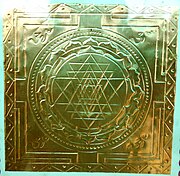
Lakshmi, also known as Shri, is one of the principal goddesses in Hinduism. She is the goddess of wealth, fortune, power, beauty and prosperity, and associated with Maya ("Illusion"). Along with Parvati and Saraswati, she forms the Tridevi of Hindu goddesses.
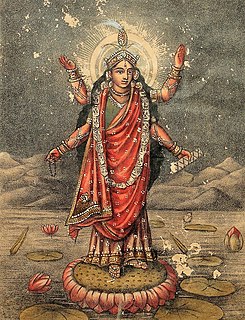
Bhairavi is a Hindu goddess, described as one of the Mahāvidyas, the ten avatars of the Mother Goddess. She is the consort of Bhairava

Sahasrara or the crown chakra is considered the seventh primary chakra in some yoga traditions.
Lalita Sahasranama is a Hindu text from the Brahmanda Purana. The Lalita Sahasranama is the thousand names of the Hindu mother goddess Lalita. It is a sacred text for the Hindu worshippers of the Goddess Lalita Devi, who considered to be a manifestation of the Divine Mother (Shakti), and the text is therefore used in the worship of Durga, Lakshmi, Parvati, Kali, Bhagavati, etc. as well. A principal text of Shakti worshipers, it names the goddess's various attributes in the form of names organized in a hymn. This sahasranama is used in various modes for the worship of the Divine Mother like parayana (recitations), archana, and homa.

Tripura Sundari, also known as Rajarajeshwari, Shodashi, and Lalita, is a Hindu goddess and is an aspect of Mahadevi mainly venerated in Shaktism, the goddess-oriented sect of Hinduism. She is also a prominent Mahavidya. She is glorified in many Shakta texts, with Lalita Sahasranama being the most popular one.

The Kamalamba Navavarana Kritis by Shri Muthuswami Dikshitar (1776-1836) are some of the most famous pieces of music in the Carnatic system of Indian classical music. They are treasures which embody not only the technical brilliance of the composer but also offer a peep into the advaitic school of Hindu philosophy and elements of Tantric rituals.
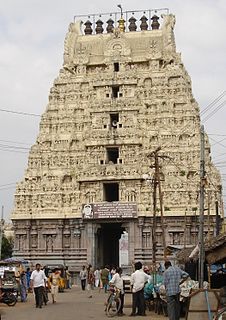
The Kamakshi Temple is an ancient Hindu Temple dedicated to Kamakshi, the ultimate Goddess Lalita Maha Tripura sundari. It is located in the historic city of Kanchipuram, near Chennai, India. The Meenakshi Temple in Madurai, the Akilandeswari temple in Thiruvanaikaval near Tiruchirappalli and this Kamakshi temple are the important centers of worship of Goddess, in the state of Tamil Nadu. The Temple was most probably built by the Pallava kings, whose capital was Kanchipuram.
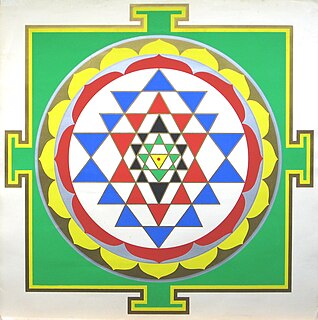
Yantra (यन्त्र) is a geometrical diagram, mainly from the Tantric traditions of the Indian religions. Yantras are used for the worship of deities in temples or at home; as an aid in meditation; used for the benefits given by their supposed occult powers based on Hindu astrology and tantric texts. They are also used for adornment of temple floors, due mainly to their aesthetic and symmetric qualities. Specific yantras are traditionally associated with specific deities and/or certain types of energies used for accomplishment of certain tasks, vows, that may be materialistic or spiritual in nature. It becomes a prime tool in certain sadhanas performed by the sadhaka the spiritual seeker. Yantras hold great importance in Hinduism, Jainism, and Buddhism.
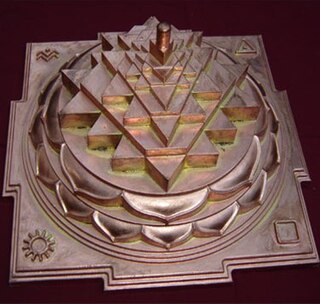
Shri Vidya is a Hindu Tantric religious system devoted to the Goddess as Lalitā Tripurasundarī, Bhuvaneshvari, etc. A thousand names for this form of Devī are recited in the Lalitā Sahasranāma, which includes Śrī Vidyā concepts. The sect accepts and aims to provide both material prosperity and self-realisation. It has an extensive literature. Details of belief vary in different texts but the general principles are similar to those found in Kashmir Shaivism. Although Shri Vidya is completely against Adi Shankara's Advaita philosophy, in some parts of India, it is believed to be originated from him.

Devipuram is a Hindu temple complex located near Visakhapatnam, Andhra Pradesh, India. Belonging primarily to the Shakta school of Hinduism, it is dedicated to the goddess Sahasrakshi, and her consort Kameshwara.

Ashta Lakshmi or Ashtalakshmi are a group of eight manifestations of Devi Lakshmi, the Hindu goddess of wealth. She presides over eight sources of wealth: "Wealth" in the context of Ashta-Lakshmi means prosperity, fertility, good fortune or good luck, good health, knowledge, strength, progeny and power.

Devī is the Sanskrit word for 'goddess'; the masculine form is deva. Devi and deva mean 'heavenly, divine, anything of excellence', and are also gender-specific terms for a deity in Hinduism.
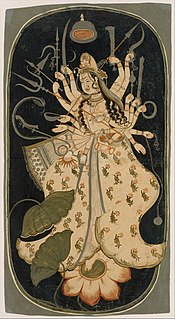
Mahadevi, also referred to as Devi, Shakti, Adi Parashakti and Adi-Shakti, Abhaya Shakti is the primordial Goddess or Divine Mother - The Supreme Energy who possesses all riches, all strength, all fame, all beauty, all knowledge, all renunciation and is the Creatrix of the universe in Hinduism. Shaivas consider her as Durga, while Shaktas consider her as bhuvaneswari and Vaishnavas consider her as Laksmi. Author Helen T Boursier says, "In Hindu philosophy both Lakshmi and Parvati are identified with the great goddess — Mahadevi — and the Shakti or divine power". Parvati is Mahadevi herself, who is the eternal soulmate of Shiva and the progenitor of Goddesses such as Durga, Kali and others
Devi Bala, also known as Bala-Ambika, is the daughter and/or younger aspect of the Hindu Goddess Bhairavi one of the ten forms of the supreme-mother Goddess.

Over the millennia of its development Hinduism has adopted several iconic symbols, forming part of Hindu iconography, that are imbued with spiritual meaning based on either the scriptures or cultural traditions. The exact significance accorded to any of the icons varies with region, period and denomination of the followers. Over time some of the symbols, for instance the Swastika has come to have wider association while others like Aum are recognized as unique representations of Hinduism. Other aspects of Hindu iconography are covered by the terms murti, for icons and mudra for gestures and positions of the hands and body.
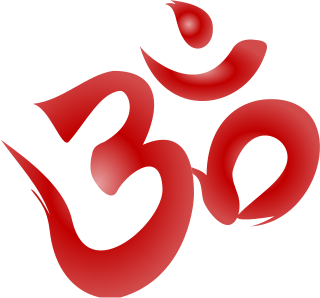
The Hamsa Upanishad is a Sanskrit text and a minor Upanishad of Hinduism. It is classified as one of the twenty Yoga Upanishads, and attached to the Shukla Yajurveda. The text or parts of the text is a relatively late origin, probably from the 2nd-millennium of the common era, but written before early 17th-century, because Dara Shikoh included it in the Persian translation of the Upanishads as Oupanekhat, spelling it as Hensnad (Hamsa-nada).

The Saubhagyalakshmi Upanishad, also called Saubhagyalakshmyupanishad (सौभाग्यलक्ष्म्युपनिषत्), Saubhagya meaning auspicious, Lakshmi a deity, Saubhagyalakshmi is a minor Upanishadic text of Hinduism. Written in Sanskrit, it is one of the 10 Upanishads attached to the Rigveda, and is classified as one of the 8 Shakta Upanishads.
As per Yoga and Tantra philosophies in Hinduism, there exist psychic Chakra's in human body. There are believed to be seven major Chakras, which are arranged vertically along the axial channel. They begin from Muladhara to Sahasrara. Each of these Chakras are presided over by six Yoginis. Lakini is the Yogini or Devi who presides over Manipura Chakra. She is referred to as the Benefactress of All.

Guru Karunamaya is an Indian spiritual guru, and religious reformer. He was born as Kompella Subba Rao and was given the Deekshanama 'Guru Karunamaya' by his spiritual teacher Sri Amrithananda Natha Saraswathi of Devipuram.
Parasurama Kalpasutra, is a Shakta Agama, Hindu text on Shri Vidya practices as per Kaula tradition and is said to be authored by Parasurama, the fifth avatar of Lord Vishnu and a disciple of Guru Dattatreya. It is a sacred text for the Shri Vidya worshippers of Goddess Lalita Devi, who is considered to be a manifestation of the Divine Mother (Shakti), and the text is therefore used in the worship of Ganesha, Bala Tripurasundari, Raja Shyamala, Varahi as well. This text has its origins in the Dattatreya Samhita and is compiled by Sumedha, a disciple of Guru Dattatreya.


